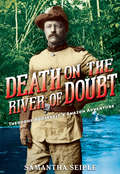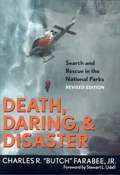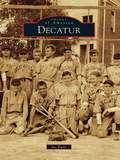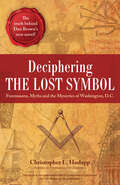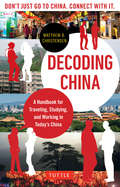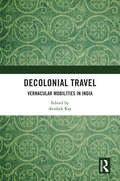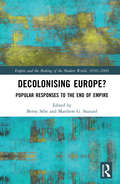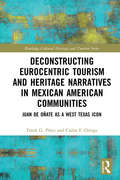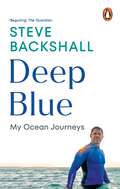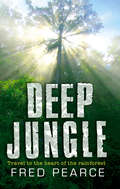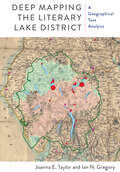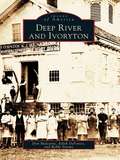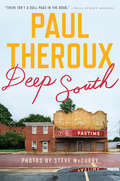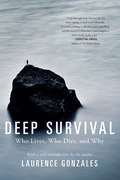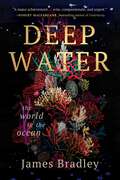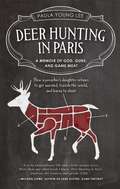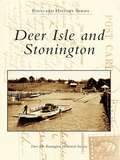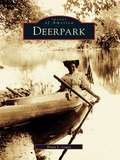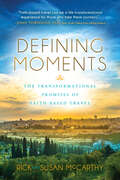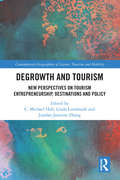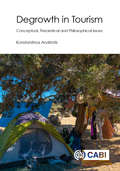- Table View
- List View
Death on the River of Doubt: Theodore Roosevelt's Amazon Adventure (Scholastic Press Non-fiction Ser.)
by Samantha SeipleThe action-packed true story of President Theodore Roosevelt's dangerous adventure down one of the most treacherous rivers on Earth.Death on the River of Doubt takes readers inside the thrilling journey that unfolds as Theodore Roosevelt and his companions navigate the Amazonian River of Doubt through an unforgiving and unpredictable jungle. With new threats at every turn, from blood-thirsty piranhas and raging rapids to starvation, disease, and a traitor in their own ranks, it seems that not everyone will make it out alive.Through it all, the indomitable Teddy Roosevelt remained determined to complete their mission and rewrite the map of the world. Or die trying.With letters, diary entries, maps, photos, and more, Death on the River of Doubt is a comprehensive narrative nonfiction thriller and the first young adult book to tell this unbelievable tale.
Death, Daring, and Disaster: Search and Rescue in the National Parks
by Charles R. Farabee Jr.375 exciting tales of heroism and tragedy drawn from the nearly 150,000 search and rescue missions carried out by the National Park Service since 1872.
Decatur (Images of America)
by Joe EarleDecatur proudly proclaims itself a city of "homes, schools, and places of worship." While that motto might seem to describe any number of small towns, the words accurately capture the essence of Decatur, a place of fine and humble homes, well-regarded schools, and large, active churches. Founded by the Georgia legislature in 1823 to be the county seat of DeKalb County, Decatur took its name from Commodore Stephen Decatur, a U.S. naval hero of the early 1800s. In the years since, Decatur has grown into a busy suburb of neighboring Atlanta, produced Agnes Scott College, and attracted both the Scottish Rite Children's Hospital and Columbia Theological Seminary. Decatur has been home to fascinating Georgians, including Civil War memoirist Mary Gay and writer Rebecca Latimer Felton, the first woman to be seated as a U.S. senator (if only for a day).
Decatur: 1832-1945 (Images of America)
by Dan GuilloryDecatur, Illinois has long had a proud tradition of workers and craftsmen who produced coal, water pumps, gloves, automobiles, clothing, corn meal, and many other products. Though it is home to Caterpillar's second largest plant and serves as world headquarters for Archer Daniels Midland, a global processor of corn and soybeans, Decatur is much more than jobs and factories. If Illinois is the Heartland, then Decatur is the Heart of the Heartland. Decatur is the site of Abraham Lincoln's first Illinois residence, in 1830, and it is where he was nominated for the presidency on May 10, 1860. Decatur is also home to a symphony orchestra, homes designed by Frank Lloyd Wright, a community college, and Millikin University.
Deciphering the Lost Symbol: Freemasons, Myths and the Mysteries of Washington, D.C.
by Christopher I HodappDiscover the secretive brotherhood behind Dan Brown’s The Lost Symbol in this unauthorized companion book by the author of Solomon’s Builders.Freemason influence on the founding of Washington, D.C., is evident throughout the city’s buildings, statues and monuments—but it’s written in coded symbols that few people understand. Dan Brown’s thriller sends symbologist detective Robert Langdon through the capital to unravel its Masonic secrets. Now in Deciphering The Lost Symbol, Freemason expert Christopher L. Hodapp compares each clue and plot twist in Brown’s story to the true facts.•Discover the meaning of “The Lost Word”•Decode Masonic and alchemical symbolism•Explore the innermost rooms of Masonic lodges and temples•Visit the restricted area of the U.S. Capitol and other landmarks•Uncover secret patterns in Washington, D.C.’s maps and monuments•Crack the codes buried in The Lost Symbol’s artwork and puzzles“Confident in recommending it to everyone, Mason and non-mason alike. This is the perfect a compliment to The Lost Symbol and I feel it should be on the shelf right next to it on your bookcase.” —David Naughton-Shires, Masonic Art Exchange
Decoding China
by Matthew B. ChristensenDo you like to know the unspoken conversations going on around you when visiting other countries? Are you someone who likes to travel on your own terms-from finding that special restaurant to negotiating a better price for a prized antique in a local flea market? If so, Decoding China is the hands-on communication guide for you!Decoding China will teach you the basic "rules of the road" on how to operate in Chinese culture. Like every country, China has its own unique set of cultural "codes," ways of behaving on a daily basis that all Chinese automatically know are the norms. These codes frame every personal interaction in China, and carry with them subtle cultural expectations that the Chinese assume everyone else knows. By learning to recognize these key codes, words and phrases-and using them correctly-then everything you do in China will go a lot more smoothly.By drawing on extensive cultural and linguistic expertise, Dr. Christensen explains the key Chinese cultural codes and how to use these to your advantage. In practical chapters organized by topic, he shows you how to get things done in China, even with very minimal knowledge of the language. Being aware of the cultural norms and a few key words and phrases will give you tremendous confidence, and allow you to "crack the code" and achieve whatever you want. Decoding China will make your China experience work for you, rather than against you, wherever you travel in the country.
Decolonial Travel: Vernacular Mobilities in India
by Avishek RayThis volume brings together scholarship on indigenous forms of travel to decolonize travel theory. It looks at certain minoritarian-vernacular traveling cults – very rarely examined – that compel us to rethink, on the one hand, the conventional tropes of and rationales for travel; and, on the other hand, notions of (post)coloniality, nationalism and modernity in the context of India. The book illustrates the enduring problematic of the ‘colonial episteme’: how it deploys pervasive categories through which travel practices are sought to be understood, and why such categories are inadequate in accounting for the vernacular traveling cults in question. In studying the vernacular world-making in and through these cults, this book offers critical insights on how they defy the log(ist)ics of the ‘imperial categories’ and why they must be read as expressions of decoloniality. An important contribution to travel studies, the book will be an indispensable resource for students and researchers of South Asian studies, travel theory, Indian literary and cultural studies, cultural history and anthropology, sociology, and decoloniality.
Decolonising Europe?: Popular Responses to the End of Empire (Empire and the Making of the Modern World, 1650-2000)
by Matthew G. Stanard Berny SèbeDecolonising Europe? Popular Responses to the End of Empire offers a new paradigm to understand decolonisation in Europe by showing how it was fundamentally a fluid process of fluxes and refluxes involving not only transfers of populations, ideas, and sociocultural practices across continents but also complex intra-European dynamics at a time of political convergence following the Treaty of Rome. Decolonisation was neither a process of sudden, rapid changes to European cultures nor one of cultural inertia, but a development marked by fluidity, movement, and dynamism. Rather than being a static process where Europe’s (former) metropoles and their peoples ‘at home’ reacted to the end of empire ‘out there’, decolonisation translated into new realities for Europe’s cultures, societies, and politics as flows, ebbs, fluxes, and cultural refluxes reshaped both former colonies and former metropoles. The volume’s contributors set out a carefully crafted panorama of decolonisation’s sequels in European popular culture by means of in-depth studies of specific cases and media, analysing the interwoven meaning, momentum, memory, material culture, and migration patterns of the end of empire across eight major European countries. The revised meaning of ‘decolonisation’ that emerges will challenge scholars in several fields, and the panorama of new research in the book charts paths for new investigations. The question mark in the title asks not only how European cultures experienced the ‘end of empire’ but also the extent to which this is still a work in progress.
Deconstructing Eurocentric Tourism and Heritage Narratives in Mexican American Communities: Juan de Oñate as a West Texas Icon (Routledge Cultural Heritage and Tourism Series)
by Frank Perez Carlos OrtegaThis book attempts to dismantle the unfounded Eurocentric view of US-born and immigrant Mexican peoples, that groups together the identities of Latinx, Chicanx, and other indigenous peoples of the Southwest into Hispanics whose contributions to the cultural, historical, and social development of the Southwest are marginalized or made non-existent. The narrative and performative legacies that tourism and fantasy heritage produce are promulgated and consumed by both Latinx and non-Latinx peoples and cultures. This book endeavors to expose these productions through analysis of on-the-ground resistance in the service and spirit of intercultural dialogue and change. This book will offer a precise set of recommendations for breaking away from these practices and thus forming new, veritable identities. With a strongly heritage-oriented discourse, this book on deconstructing Eurocentric representation of Mexican people and their culture will appeal to academics and scholars of heritage tourism, Chicano studies, Southwest studies and Native American studies courses.
Deep Blue: My Ocean Journeys
by Steve BackshallTake a deep breathSteve Backshall was nine years old the first time he saw a shark, while on holiday with his family in Malaysia. It was the beginning of a life-long fascination with these 'lords of the sea', and the oceanic life around them. His career as one of the world's most popular naturalists and explorers has taken him to countless underwater places, many never before seen by others. And he's also been witness to the startling decline in fortune of our oceans' wild inhabitants over the past fifty years.Deep Blue is a book a lifetime in the making: a remarkable blend of memoir, travel, and marine and environmental science that takes us on an unforgettable tour of the many worlds of aquatic life: from underwater deserts and rainforests to the evolution of ocean heroes like the sea turtle and the Great White, from the genesis of ocean life to the rapidly declining state of white polar seas and coral reefs. It's both a love letter to our precious oceans and rallying cry for what we must to do save them.
Deep Jungle: Journey To The Heart Of The Rainforest
by Fred PearceDEEP JUNGLE is an exploration of the most alien and feared habitat on Earth. Starting with man's earliest recorded adventures, Fred Pearce journeys high into the canopy - home to two-thirds of all the creatures on our planet, many of whom never come down to earth. During his travels he encounters all manner of fantastic flora and fauna, including a frog that can glide from tree to tree, a spider that can drag live chickens into its burrow and a flower that smells of decaying flesh.It is in the jungle that Pearce discovers secrets about how evolution works, the intricate links that connect us all, and maybe even clues to where humans came from - here is the key to our future foods and medicines, our climate and our understanding of how life works. At the start of a new millennium Pearce asks why we continue to waste precious time - and billions of dollars - looking for signs of life elsewhere in our universe when the greatest range of life-forms that have ever existed lies right here on our doorstep. Today environmentalists say we are on the verge of destroying the last rainforests, and with them the planet's evolutionary crucible, and maybe even its ability to maintain life on Earth. But nature has a way of getting its own back. The Mayans and the people of Angkor went too far in manipulating nature and paid the ultimate price. Their civilisations died and the jungle returned. Nature reclaimed it's own and it may do so again ...
Deep Mapping the Literary Lake District: A Geographical Text Analysis (Aperçus: Histories Texts Cultures)
by Ian N. Gregory Joanna E. TaylorEngland’s famed Lake District—best known as the place of inspiration for the Wordsworths, Samuel Taylor Coleridge, and other Romantic-era writers—is the locus of this pioneering study, which implements and critiques a new approach to literary analysis in the digital age. Deploying innovative methods from literary studies, corpus linguistics, historical geography, and geographical information science, Deep Mapping the Literary Lake District combines close readings of a body of writing about the region from 1622-1900 with distant approaches to textual analysis. This path-breaking volume exemplifies interdisciplinarity, demonstrating how digital humanities methodologies and geospatial tools can enhance our appreciation of a region whose topography has been long recognized as fundamental to the shape of the poetry and prose produced within it.
Deep River and Ivoryton (Images of America)
by Robbi Storms Don Malcarne Edith DeforestDeep River and Ivoryton, two villages in the lower Connecticut River Valley, were dominated for more than a century by "white gold"-ivory. The growth of the piano industry led to a new use for this exotic and long-treasured substance and, suddenly, the two villages became tied to Zanzibar, the most important exporting place for the tusks of African elephants.With more than two hundred exceptional photographs and narrative, Deep River and Ivoryton tells the story of how ivory shaped the economy and culture of these villages. Two companies, Pratt, Read & Company and the Comstock, Cheney & Company, employed thousands of people in satisfying the demand for new pianos. Probably more than ninety percent of the ivory processed in this country was handled in Deep River and Ivoryton. The demand for new instruments slowed with the invention of the radio, followed by the Great Depression of the 1930s, and the flow of material stopped altogether in the 1950s, when the use of ivory in the United States was banned.
Deep South's Oldest Rivalry, The: Auburn vs. Georgia (Sports)
by Douglas StutsmanThe rivalry between Auburn University and the University of Georgia began in 1892 and has largely been a competition more brotherly than bitter. According to one legend, Auburn’s “War Eagle” battle cry originated at the first game between the two schools. The first overtime game in SEC history occurred in 1996, when Georgia topped the heavily favored Tigers, 56–49, in four extra periods. Renowned UGA coach Vince Dooley graduated from Auburn, while Auburn coach Pat Dye was an All-American at UGA. Join award-winning journalist Doug Stutsman as he recounts the unforgettable games, moments and personalities on the 125th anniversary of the Deep South’s Oldest Rivalry.
Deep South: Four Seasons On Back Roads
by Paul TherouxThe acclaimed author of The Great Railway Bazaar takes a revealing journey through the Southern US in a &“vivid contemporary portrait of rural life&” (Atlanta Journal-Constitution). Paul Theroux has spent decades roaming the globe and writing of his experiences with remote people and far-flung places. Now, for the first time, he turns his attention to a corner of America—the Deep South. On a winding road trip through Mississippi, South Carolina, and elsewhere below the Mason-Dixon, Theroux discovers architectural and artistic wonders, incomparable music, mouth-watering cuisine—and also some of the worst schools, medical care, housing, and unemployment rates in the nation. Most fascinating of all are Theroux&’s many encounters with the people who make the South what it is—from preachers and mayors to quarry workers and gun show enthusiasts. With his astute ear and penetrating mind, Theroux once again demonstrates his &“remarkable gift for getting strangers to reveal themselves&” in this eye-opening excursion into his own country (The New York Times Book Review). &“Paul Theroux&’s latest travel memoir had me at hello…Theroux pulls no punches in his quest to understand this overlooked margin of American life.&” — Boston Globe
Deep Survival: Who Lives, Who Dies, And Why
by Laurence Gonzales"Unique among survival books... stunning... enthralling. Deep Survival makes compelling, and chilling, reading."--Penelope Purdy, Denver Post In ?Deep Survival?, Laurence Gonzalez combines hard science and powerful storytelling to illustrate the mysteries of survival, whether in the wilderness or in meeting any of life's great challenges. This gripping narrative, the first book to describe the art and science of survival, will change the way you see the world. Everyone has a mountain to climb. Everyone has a wilderness inside.
Deep Water: The World in the Ocean
by James Bradley"Deep Water is a major achievement....Bradley's skills both as novelist and essayist converge here to create this wise, compassionate and urgent book, characterized throughout by a clarity of prose and a bracing moral gaze that searches water, self and reader." —ROBERT MACFARLANE, bestselling author of UnderlandIn this thrilling work—a blend of history, science, nature writing, and environmentalism—acclaimed writer James Bradley plunges into the unknown to explore the deepest recesses of the natural world.Seventy-one percent of the earth’s surface is ocean. These waters created, shaped, and continue to sustain not just human life, but all life on Planet Earth, and perhaps beyond it. They serve as the stage for our cultural history—driving human development from evolution through exploration, colonialism, and the modern era of global leisure and trade. They are also the harbingers of the future—much of life on Earth cannot survive if sea levels are too low or too high, temperatures too cold or too warm. Our oceans are vast spaces of immense wonder and beauty, and our relationship to them is innate and awe inspired.Deep Water is both a lyrically written personal meditation and an intriguing wide-ranging reported epic that reckons with our complex connection to the seas. It is a story shaped by tidal movements and deep currents, lit by the insights of philosophers, scientists, artists and other great minds. Bradley takes readers from the atomic creation of the oceans, to the wonders within, such as fish migrations guided by electromagnetic sensing. He describes the impacts of human population shifts by boat and speaks directly and uncompromisingly to the environmental catastrophe that is already impacting our lives. It is also a celebration of the ocean’s glories and the extraordinary efforts of the scientists and researchers who are unlocking its secrets. These myriad strands are woven together into a tapestry of life that captures not only our relationship with the planet, but our past, and perhaps most importantly, what lies ahead for us.A brilliant blend of Robert MacFarlane’s Underland, Susan Casey’s The Underworld, and Simon Winchester’s Pacific and The Atlantic, Deep Water taps into the essence of our planet and who we are.
Deer Hunting in Paris
by Paula Young LeeWhat happens when a Korean-American preacher's kid refuses to get married, travels the world, and quits being vegetarian? She meets her polar opposite on an online dating site while sitting at a café in Paris, France and ends up in Paris, Maine, learning how to hunt. A memoir and a cookbook with recipes that skewer human foibles and celebrates DIY food culture, Deer Hunting in Paris is an unexpectedly funny exploration of a vanishing way of life in a complex cosmopolitan world. Sneezing madly from hay fever, Lee recovers her roots in rural Maine by running after a headless chicken, learning how to sight in a rifle, shooting skeet, and butchering animals. Along the way, she figures out how to keep her boyfriend's conservative Republican family from "mistaking" her for a deer and shooting her at the clothesline.
Deer Isle and Stonington
by Deer Isle-Stonington Historical SocietyThe island communities of Deer Isle and Stonington lie in Penobscot Bay, a region known and loved by sailors the world over. Deer Isle and Stonington portrays life on the island from the age of ferries and steamships, to the building of the Deer Isle-Sedgwick Bridge, through World War II. These vintage photographs allow the reader to watch as the island's main streets grow and change. Represented are landmarks such as the Mark and Pumpkin Island lighthouses, the Stonington Opera House, and the oldest buildings on the island. The vital industries of seafaring, sail making, commercial fishing, granite quarrying, and yachting are pictured here alongside images of everyday life-celebrations and ceremonies, shopping and picnics, education and worship, work and play.
Deer Isle and Stonington (Images of America)
by Deer Isle-Stonington Historical SocietyThe island communities of Deer Isle and Stonington lie in Penobscot Bay, a region known and loved by sailors the world over. Deer Isle and Stonington portrays life on the island from the age of ferries and steamships, to the building of the Deer Isle-Sedgwick Bridge, through World War II. These vintage photographs allow the reader to watch as the island's main streets grow and change. Represented are landmarks such as the Mark and Pumpkin Island lighthouses, the Stonington Opera House, and the oldest buildings on the island. The vital industries of seafaring, sail making, commercial fishing, granite quarrying, and yachting are pictured here alongside images of everyday life-celebrations and ceremonies, shopping and picnics, education and worship, work and play.
Deerpark (Images of America)
by Brian J. LewisBounded by three rivers and a mountain range, the town of Deerpark lies in the southwestern corner of Orange County. Once the frontier of America, the area took its name from what early settlers called their neighbor's fenced tract: McDaniel's Deer Park. The town has seven hamlets-Cahoonzie, Cuddebackville, Godeffroy, Huguenot, Rio, Sparrowbush, and Westbrookville-shaped and identified by their geography.Deerpark highlights a community that has what is believed to be the oldest one-hundred-mile road in the country, the Old Mine Road. Appearing in this pictorial history are the Delaware and Hudson Canal, which transformed the town, and the railroad, which spawned a thriving resort industry. Also shown are filmmaker D.W. Griffith, who between 1909 and 1911 made silent movies using the mountains and rivers as a backdrop, and many ancestors of present-day residents.
Defining Moments: The Transformational Promises of Faith-Based Travel
by Susan McCarthy Rick McCarthyA guide to faith-based, Spirit-led, heart-changing travel to the Holy Land and historic Christian sites throughout Europe.Travel is the one thing that makes you richer after you pay for it—and that’s especially true when itineraries are designed to provide a life-changing spiritual revelation experience. This guide is ideal for individuals and tour leaders who want to bring the Holy Spirit along on their journeys as they seek defining moments with God.Covering destinations such as Antioch, Bethlehem, Emmaus, Corinth, Canterbury, Zurich, and many more, Defining Moments not only allows you to follow in the footsteps of Paul’s missionary journeys or learn more about the Reformation, but deepens your experience in ways that can restore, revive, and re-energize your faith—turning travel into transformation. Also included are numerous practical tips about preparing for your trip, navigating unfamiliar places, touring with a group, and more.
Degrowth and Tourism: New Perspectives on Tourism Entrepreneurship, Destinations and Policy (Contemporary Geographies of Leisure, Tourism and Mobility)
by C. Michael Hall; Linda Lundmark; Jundan Jasmine ZhangThe sustainability of tourism is increasingly under question given the challenges of overtourism, COVID-19 and the contribution of tourism to climate and environmental change. Degrowth and Tourism provides an original response to the central problem of growth in tourism, an imperative that has been intrinsic within tourism practice, and directs the reader to rethink the impacts of tourism and possible alternatives beyond the sustainable growth discourse. Using a multi-scaled approach to investigate degrowth’s macro effects and micro indications in tourism, this book frames degrowth in tourism in terms of business, destination and policy initiatives. It uses a combination of empirical research, case studies and theory to offer new perspectives and approaches to analyse issues related to overtourism, COVID-19, small-scale tourism operations and entrepreneurship, mobility and climate change in tourism. Interdisciplinary chapters provide studies on animal-based tourism, nature-based tourism, domestic tourism, developing community-centric tourism and many other areas, within the paradigm of degrowth. This book offers significant insight on both the implications of degrowth paradigm in tourism studies and practices, as well as tourism’s potential contributions to the degrowth paradigm, and will be essential reading for all those interested in sustainable tourism and transformations through tourism.
Degrowth in Tourism: Conceptual, Theoretical And Philosophical Issues
by Konstantinos AndriotisThe modern-day world faces a hostile climate, depleted resources and the destruction of habitats. The dream that growth will lead to a materialistic utopia is left unfulfilled by a lack of ecological and economic capacity. The only choice is to find alternatives to increased growth, transform the structures and institutions currently shaping the world, change lifestyles and articulate a more credible vision for the future and lasting prosperity. As a reaction to the problems accrued by capitalism, new development approaches such as the concept of degrowth have evolved. <P><P>Degrowth in Tourism explores newly-emerging development and philosophical approaches that provide more equity for host communities and offer a low-carbon future by looking at alternatives to the classic models of development and applying the concept of degrowth in a tourism context. <P><P>Proposing that we need to shift tourism research from models which prioritize commodified tourism experiences to those that offer alternative decommodified ones, this book: <P><P>- Provides topical analysis and illustrates the key themes of degrowth; - Discusses the relationship between tourism and degrowth from both a historic perspective and through contemporary patterns of activity; - Includes international examples and case studies to translate theory into practical new approaches. <P><P>A comprehensive review of the subject, this book will be of great interest to researchers and practitioners within tourism, development, environment and economics, as well as those specifically studying degrowth.
Degrowth in Tourism: Conceptual, Theoretical and Philosophical Issues
by Dr Konstantinos AndriotisThe modern-day world faces a hostile climate, depleted resources and the destruction of habitats. The dream that growth will lead to a materialistic utopia is left unfulfilled by a lack of ecological and economic capacity. The only choice is to find alternatives to increased growth, transform the structures and institutions currently shaping the world, change lifestyles and articulate a more credible vision for the future and lasting prosperity. As a reaction to the problems accrued by capitalism, new development approaches such as the concept of degrowth have evolved. Degrowth in Tourism explores newly-emerging development and philosophical approachesthat provide more equity for host communities and offer a low-carbon future by looking at alternatives to the classic models of development and applying the concept of degrowth in a tourism context. Proposing that we need to shift tourism research from models which prioritize commodified tourism experiences to those that offer alternative decommodified ones, this book: - Provides topical analysis and illustrates the key themes of degrowth; - Discusses the relationship between tourism and degrowth from both a historic perspective and through contemporary patterns of activity; - Includes international examples and case studies to translate theory into practical new approaches. A comprehensive review of the subject, this book will be of great interest to researchers and practitioners within tourism, development, environment and economics, as well as those specifically studying degrowth.
